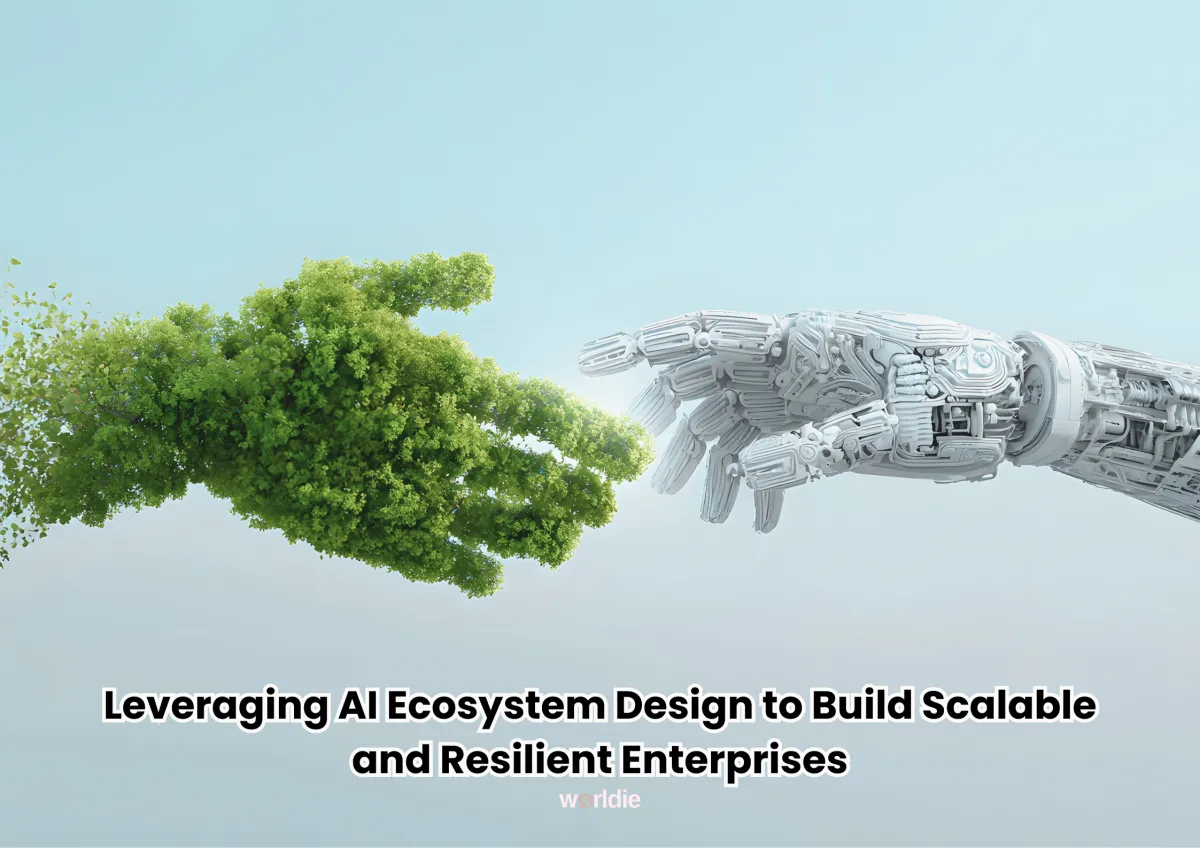
Leveraging AI Ecosystem Design to Build Scalable and Resilient Enterprises
Designing AI ecosystems for sustainable business scaling is more than a trend; it’s a fundamental shift in how modern enterprises operate, grow, and compete. Artificial intelligence has evolved from an experimental technology into a core infrastructure for organizations that want to achieve long-term growth and resilience. For forward-thinking founders, executives, and growth teams, understanding how to design, implement, and evolve an AI ecosystem is the key to staying ahead in a data-driven economy.
Worldie AI has built its expertise around helping businesses create these intelligent ecosystems — systems that don’t just automate tasks but actively optimize, predict, and innovate. The goal is not just to add AI to business operations but to design an ecosystem where technology, data, and human expertise work together to continuously drive value.
Understanding the Concept: What an AI Ecosystem Really Means
An AI ecosystem refers to the interconnected framework of technologies, models, data pipelines, and human workflows that enable a business to leverage artificial intelligence efficiently. It’s not one single tool or model; it’s a living system designed to learn, adapt, and scale over time.
When designed properly, this ecosystem aligns with business strategy, integrates with core operations, and supports a culture of innovation. Instead of being a series of disconnected automation tools, it becomes the central nervous system of the enterprise, coordinating insights and actions across departments.
Why Sustainable Scaling Demands AI Ecosystems
Traditional business scaling models rely heavily on human labor and manual processes. This often leads to inefficiencies, high costs, and inconsistent results. As data volume and customer expectations increase, scaling without automation becomes unsustainable.
AI ecosystems change this dynamic. They create a foundation where growth is not limited by workforce size or process bottlenecks. Machine learning models automate pattern recognition, predictive systems forecast demand, and intelligent agents handle routine interactions — allowing human teams to focus on strategy and creativity.
This kind of sustainable scaling doesn’t just mean doing more with less. It means creating systems that continuously improve themselves, learning from every decision, transaction, and interaction.
Common Inefficiencies in Modern Enterprises
Most organizations face the same barriers to growth — fragmented systems, siloed data, and inconsistent process execution. Sales data doesn’t align with customer service insights. Marketing campaigns aren’t connected to supply chain forecasts. Departments work in isolation, creating inefficiencies that slow down innovation and decision-making.
Without integration, data remains underutilized. Without AI-driven analysis, insights are missed. Without automation, teams spend too much time on repetitive work that adds little strategic value. These inefficiencies don’t just cost time; they prevent enterprises from scaling intelligently.
How AI Ecosystems Resolve Business Friction
When an organization embraces AI-driven systems, those friction points start to dissolve. Predictive analytics provides real-time clarity. Natural language processing enhances communication between humans and systems. Machine learning refines decision-making with every cycle of feedback.
A well-designed AI ecosystem transforms departments into interconnected intelligence hubs. Instead of working in isolation, every team draws from the same continuously updated insights. Marketing can predict which leads are most likely to convert, operations can anticipate supply shortages, and finance can forecast cash flow with higher accuracy.
Use Cases Across Industries
AI ecosystems are not limited to a specific vertical. In manufacturing, predictive maintenance systems reduce downtime and optimize production schedules. In healthcare, AI assists in patient diagnostics and administrative automation. In financial services, algorithmic systems streamline compliance, fraud detection, and customer engagement.
Retail and e-commerce companies are using AI-driven recommendation engines to personalize customer experiences. Logistics and transportation businesses optimize route planning and resource allocation. Even professional services firms are integrating AI assistants to handle repetitive analysis and reporting tasks, freeing up consultants for higher-value work.
Every industry has a unique application, but the principle remains constant: scalable growth through intelligent automation and data-driven optimization.
The Worldie AI Approach: Design → Build → Release
Worldie AI’s structured approach to AI ecosystem development ensures that businesses don’t just adopt technology — they operationalize intelligence.
The design phase focuses on mapping out processes, identifying bottlenecks, and defining the role AI should play within each workflow. This involves deep collaboration with leadership teams to ensure that every AI system aligns with broader business objectives.
The build phase is where infrastructure takes shape. AI models are trained, data pipelines are integrated, and automation systems are developed to communicate seamlessly. This is where machine learning, APIs, and enterprise software converge into a unified framework.
The release phase involves deploying these systems across the organization. Teams are trained, processes are refined, and continuous feedback loops are established to ensure ongoing improvement. It’s not about one-time implementation; it’s about creating a foundation that grows more intelligent over time.
Challenges in AI Deployment
Integrating AI across an enterprise isn’t without complexity. The most common challenges include data quality issues, limited infrastructure readiness, and lack of internal AI literacy. Many organizations underestimate the cultural shift required to support AI systems effectively.
Resistance to change, fear of job displacement, and insufficient understanding of AI’s capabilities can stall progress. Without proper data governance, even the most sophisticated models can fail to deliver accurate insights.
This is where expert guidance becomes critical. A successful deployment requires both technological and organizational alignment — a balance between innovation and practical adoption.
Creating the Right Data Infrastructure
Data is the foundation of any AI ecosystem. Without clean, structured, and accessible data, AI systems cannot function effectively. Businesses must prioritize establishing strong data governance frameworks, ensuring accuracy, consistency, and compliance.
Worldie AI helps enterprises build centralized data hubs, connecting previously fragmented systems into unified databases. This creates a single source of truth from which AI models can continuously learn and improve. The stronger the data foundation, the more scalable and accurate the ecosystem becomes.
Integrating AI Seamlessly into Existing Operations
One of the biggest hurdles organizations face is integrating new AI systems with legacy technologies. Worldie AI approaches this by focusing on interoperability — ensuring that AI tools communicate effectively with existing CRMs, ERPs, and workflow software.
This step is not just technical; it’s strategic. Integration requires change management, staff retraining, and new workflows that maximize human-AI collaboration. Instead of replacing human roles, AI enhances them, allowing teams to focus on creative and analytical problem-solving while routine processes run autonomously.
Building Organizational Readiness
Before an AI ecosystem can scale effectively, the organization itself must be ready. Leadership alignment, team education, and clear communication are essential. Employees should understand what AI does, how it benefits their role, and how they can use it to work more efficiently.
Worldie AI often begins with pilot programs — smaller implementations that demonstrate immediate value. Once the benefits are visible, scaling across departments becomes significantly smoother. This approach minimizes risk and builds internal confidence in AI adoption.
Metrics That Define AI Success
Measuring the impact of AI goes beyond tracking output. Success metrics include process efficiency, accuracy of predictive models, and improvement in customer experience. Financial KPIs such as reduced operational costs and accelerated revenue growth also serve as indicators of ecosystem performance.
Worldie AI emphasizes continuous evaluation — refining algorithms, updating data pipelines, and re-aligning AI initiatives with changing business goals. The ecosystem isn’t static; it evolves alongside the enterprise.
Real-World Transformations with AI Ecosystems
Across industries, AI ecosystems are already proving transformative. A logistics company that integrated AI route optimization reduced fuel costs and delivery times significantly. A retail brand implementing dynamic pricing algorithms saw substantial growth in profit margins.
These are not isolated success stories. They represent the broader shift toward intelligent infrastructure that enables scalable, data-driven business growth. Enterprises that commit to AI ecosystems gain a competitive edge that compounds over time.
The Future of Sustainable AI Scaling
As technology advances, sustainable AI scaling will depend on adaptability. Enterprises must continuously evolve their AI ecosystems to meet changing market conditions, regulatory frameworks, and customer expectations.
Sustainability in AI doesn’t just refer to environmental responsibility — it means building systems that are maintainable, secure, and capable of evolving intelligently without constant reinvention. With the right strategy and partner, AI becomes not just a growth tool but a long-term strategic advantage.
Worldie AI’s Vision for Intelligent Ecosystems
Worldie AI envisions a future where enterprises are powered by adaptive intelligence — systems that learn, predict, and evolve in real-time. By designing AI ecosystems tailored to each business’s unique model, Worldie AI enables organizations to scale efficiently, reduce friction, and unlock new revenue streams.
These ecosystems aren’t theoretical; they’re operational frameworks that redefine what growth looks like in a digital economy.
FAQs
1. What is the first step in designing an AI ecosystem for sustainable scaling?
The first step involves assessing current processes, identifying inefficiencies, and determining where AI can provide measurable improvements. It’s essential to map out data sources, workflows, and business goals before building the technical infrastructure.
2. How long does it take to integrate AI into an enterprise business model?
Integration timelines vary depending on the complexity of systems, data quality, and organizational readiness. In most cases, businesses can start seeing early results from AI pilot programs within three to six months.
3. What are the most common mistakes organizations make when adopting AI?
One major mistake is implementing AI tools without a cohesive strategy or sufficient data infrastructure. Others include overlooking staff training, underestimating integration challenges, and failing to measure long-term ROI.
4. How can AI ecosystems remain sustainable over time?
Sustainability comes from ongoing monitoring, model retraining, and continuous optimization. A well-designed ecosystem is built to evolve, adapting to new data, technologies, and market shifts without requiring complete reinvention.
5. Why choose Worldie AI for designing and deploying AI ecosystems?
Worldie AI brings deep expertise in aligning AI infrastructure with business objectives. Its structured design-build-release framework ensures that each system is scalable, integrated, and purpose-built to deliver real revenue impact.

